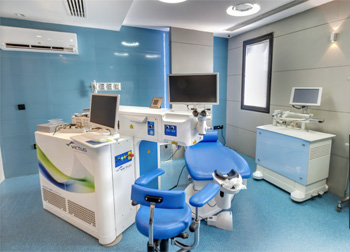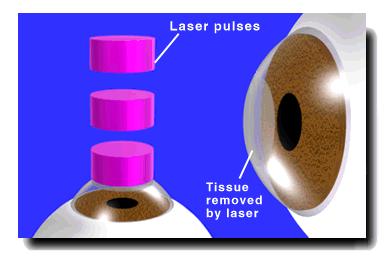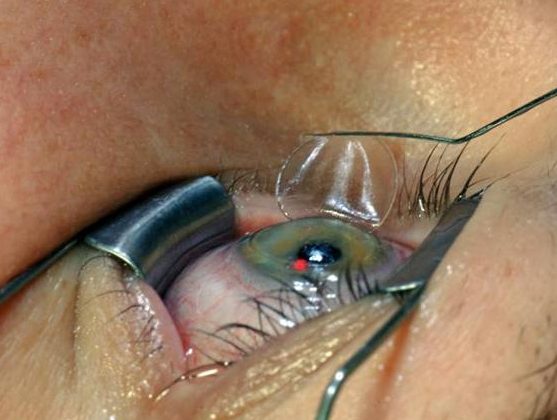Femto-LASIK Surgery Package : 1500$
“The most advanced device for Lasik operation called Femotlasik began its operation in Parsian clinic”
This brochure (the above image) and the title represent the news published in 2007 for installation and initiation of the first Femtosecond laser device of the country in Parsian clinic.
Femtosecond laser is a very advanced laser which is widely used in ophthalmology and many operations of the eyes including corneal transplantation, femtolasik, and Smile are performed using this laser. The incisions developed by this device are more controlled and precise surgical blade through the guidance of advanced computer software.
Lasik
Lasik is one of the common methods for correcting refractive defects which was introduced following PRK. The difference between Lasik and PRK is first the operation and then is radiation of laser beams, which is common in every operation. In Lasik operation, a layer with a thickness of around 150 micron of the corneal surface is removed. This layer is called flap, which includes epithelium and part of the main tissue of the cornea (stroma). This layer is connected to cornea with a hinge-shaped base layer. Then this layer is removed and laser operation is performed on the cornea using Eximer laser. At the end, this layer is placed back to its original position and interestingly this layer attaches to cornea spontaneously and there is no need to suture. This layer heals very fast and due to this rapid healing, the vision of the patient is corrected very soon, and there will be the minimal pain and discomfort after the operation. These two factors are among the major advantages of this operation. Nevertheless, the major problem of Lasik operation is the complications which may develop when removing the corneal layer. In order to remove the corneal layer (flap), a device called “microkeratome” is used. This device function similarly to a commercial grate, and via the blade it has it creates very delicate incision on the corneal surface which is flap. Then, the surgeon lifts the flap and performs the laser operation and then returns the flap to its original position, whereby the operation is completed. Although microkeratome performs its function well in most cases and no problem develops, in very rare cases it may not function properly. In addition, since in Lasik a thinner layer of cornea is removed, the strength of cornea may be affected and create some problems for the patient.
Femtolasik
With gaining access to Femtolasik technology, we managed to provide our patients with newer and more advanced facilities. Femtolasik is an advanced operation replacing conventional Lasik. Indeed, this operation is the advanced form of Lasik. In this operation, as with Lasik, a layer (flap) is removed from the cornea. However, unlike conventional Lasik in which the laser removal is performed by a mechanical device called microkeratome, in Femtolasik, the layer removal is performed by femtosecond laser, which is able to create very precise and delicate incisions in the corneal tissue. Using this laser, one can create incisions in any shape and size and at any depth of cornea which is desired. That flap created by this device is thinner and more precise than the one created by microkeratome. Also, the surface of the cornea is smoother after usage of this device. In this operation, again once the corneal flap was removed, Eximer laser does its duty which is correcting the refractive defects of the eyes. The advantages of Femtolasik over conventional Lasik and PRK include the following:
Femtolasik advantages over conventional Lasik:
- performing all stages of the operation by laser without using any blades
- reducing the chance of infection and transmission of microbial agents via surgical tools
- reducing the probability of reoperation
- fewer complications, greater accuracy and safety
The advantages of Femtolasik over PRK:
- shorter time of healing and fast recovery of vision
- no pain and discomfort on the day after the operation
- faster return to routine activities and jobs
- no need to consuming extra drugs during the operation
- no need to consuming drugs for a long time following operation
Note that in centers which have access to Femtolasik, conventional Lasik has been abolished and has been replaced with Femtolasik.
The stages of Lasik operation through microkeratome device
The view of the stages of Lasik operation with microkeratome, from left to right : first a sucker ring which has also a dented rail is placed on the eyes. This rig with its suction power which has kept the eyes fixed elevates the eye pressure to an adequately high level, causing the microkeratome device to move on the eyes. Thereafter, this device moves on the eyes and removes a thin layer called flap from the cornea. The device stops at the terminal 1 mm so that the layer would not be completely removed from the cornea and create a base such as a hinge. Next, the laser beams are radiated to the cornea and then the flap moves back to its position.
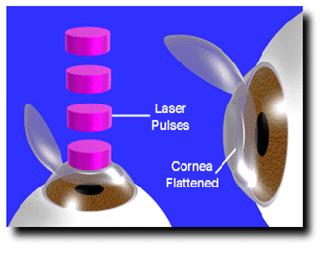
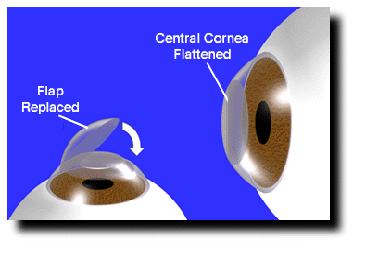
The following figure is related to PRK and trans. As can be observed, the flap is not removed from the cornea and laser beams are radiated directly to the cornea.
As mentioned earlier, today Lasik has been replaced with Femtolasik, and this advanced laser has also superseded microkeratome, and is used to create flap.
The following figure indicates a view of the flap developed by Femtolasik device

